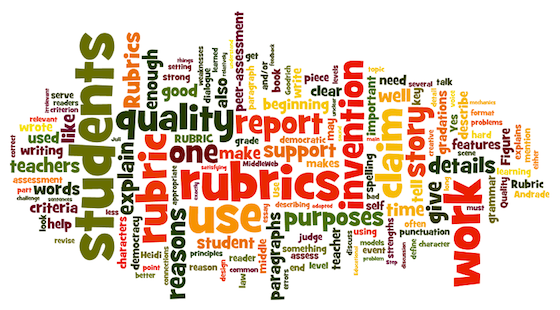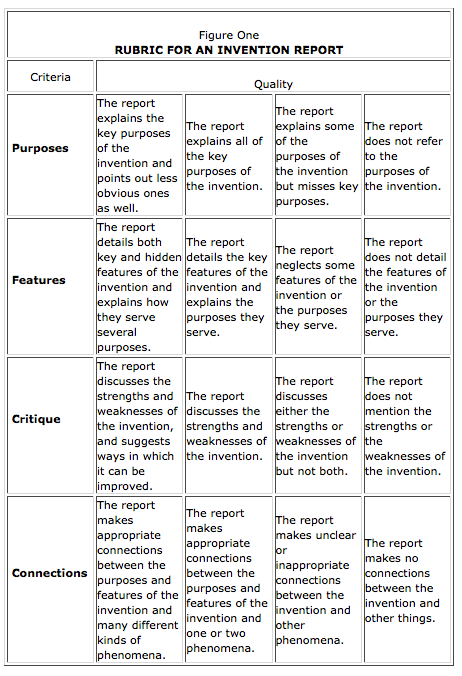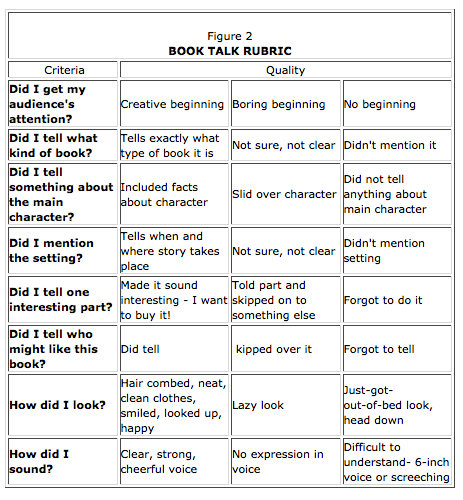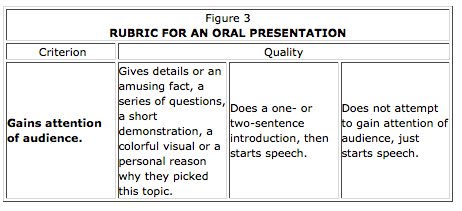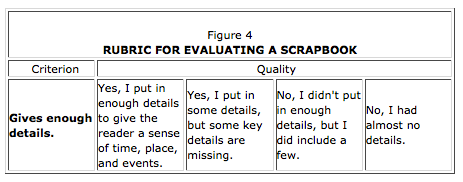A MiddleWeb Classic: Exploring Rubrics!
A little history: This article first appeared on the MiddleWeb site (with permission from the author) in 1997, in the early years of rubrics in the classroom. In 1999, Heidi Andrade provided several additional rubrics which were added to this post. Since that time, we’ve added a selection of quality rubrics contributed by teachers. More than 20 years after this material first appeared at our original website, it continues to draw excellent traffic. Rubric users can learn a lot here!
For more contemporary resources, including Common Core perspectives, be sure to visit our MiddleWeb resource roundup: All About Rubrics.
Understanding Rubrics
originally published in Educational Leadership, 54(4)
© Heidi Goodrich 1996
What Is a Rubric?

The example in Figure 1 (adapted from Perkins et al 1994) lists the criteria and gradations of quality for verbal, written, or graphic reports on student inventions – for instance, inventions designed to ease the Westward journey for 19th century pioneers for instance, or to solve a local environmental problem, or to represent an imaginary culture and its inhabitants, or anything else students might invent.
This rubric lists the criteria in the column on the left: The report must explain (1) the purposes of the invention, (2) the features or parts of the invention and how they help it serve its purposes, (3) the pros and cons of the design, and (4) how the design connects to other things past, present, and future. The rubric could easily include criteria related to presentation style and effectiveness, the mechanics of written pieces, and the quality of the invention itself.
The four columns to the right of the criteria describe varying degrees of quality, from excellent to poor. As concisely as possible, these columns explain what makes a good piece of work good and a bad one bad.
Why use rubrics?
Rubrics appeal to teachers and students for many reasons. First, they are powerful tools for both teaching and assessment. Rubrics can improve student performance, as well as monitor it, by making teachers’ expectations clear and by showing students how to meet these expectations. The result is often marked improvements in the quality of student work and in learning. Thus, the most common argument for using rubrics is they help define “quality.” One student actually didn’t like rubrics for this very reason: “If you get something wrong,” she said, “your teacher can prove you knew what you were supposed to do!” (Marcus 1995).
A second reason that rubrics are useful is that they help students become more thoughtful judges of the quality of their own and others’ work. When rubrics are used to guide self- and peer-assessment, students become increasingly able to spot and solve problems in their own and one another’s work. Repeated practice with peer-assessment, and especially self-assessment, increases students’ sense of responsibility for their own work and cuts down on the number of “Am I done yet?” questions.
Third, rubrics reduce the amount of time teachers spend evaluating student work. Teachers tend to find that by the time a piece has been self- and peer-assessed according to a rubric, they have little left to say about it. When they do have something to say, they can often simply circle an item in the rubric, rather than struggling to explain the flaw or strength they have noticed and figuring out what to suggest in terms of improvements. Rubrics provide students with more informative feedback about their strengths and areas in need of improvement.
Fourth, teachers appreciate rubrics because their “accordion” nature allows them to accommodate heterogeneous classes. The examples here have three or four gradations of quality, but there is no reason they can’t be “stretched” to reflect the work of both gifted students and those with learning disabilities.
Finally, rubrics are easy to use and to explain. Christine Hall, a fourth grade teacher, reflected on how both students and parents responded to her use of rubrics:
“Students were able to articulate what they had learned, and by the end of the year could be accurate with their evaluations. Parents were very excited about the use of rubrics. During parent conferences I used sample rubrics to explain to parents their purpose, and how they were used in class. The reaction of parents was very encouraging. They knew exactly what their child needed to do to be successful.”
How Do You Create Rubrics?
Rubrics are becoming increasingly popular with educators moving toward more authentic, performance- based assessments. Recent publications contain some rubrics (Brewer 1996; Marzano et al 1993). Chances are, however, that you will have to develop a few of your own rubrics to reflect your own curriculum and teaching style. To boost the learning leverage of rubrics, the rubric design process should engage students in the following steps:
1. Look at models: Show students examples of good and not-so-good work. Identify the characteristics that make the good ones good and the bad ones bad.
2. List criteria: Use the discussion of models to begin a list of what counts in quality work.
3. Articulate gradations of quality: Describe the best and worst levels of quality, then fill in the middle levels based on your knowledge of common problems and the discussion of not-so-good work.
4. Practice on models: Have students use the rubrics to evaluate the models you gave them in Step 1.
5. Use self- and peer-assessment: Give students their assignment. As they work, stop them occasionally for self- and peer-assessment.
6. Revise: Always give students time to revise their work based on the feedback they get in Step 5.
7. Use teacher assessment: Use the same rubric students used to assess their work yourself.
Step 1 may be necessary only when you are asking students to engage in a task with which they are unfamiliar. Steps 3 and 4 are useful but time-consuming; you can do these on your own, especially when you’ve been using rubrics for a while. A class experienced in rubric-based assessment can streamline the process so that it begins with listing criteria, after which the teacher writes out the gradations of quality, checks them with the students, makes revisions, then uses the rubric for self-, peer-, and teacher assessment.
Ann Tanona, a second grade teacher, went through the seven-step process with her students. The result was a rubric for assessing videotaped Reading Rainbow-style “book talks” (fig. 2).
Tips on designing rubrics
Ann’s rubric is powerful because it articulates the characteristics of a good “book talk” in students’ own words. It also demonstrates some of the difficulties of designing a good rubric.
Perhaps the most common challenge is avoiding unclear language, such as “creative beginning.” If a rubric is to teach as well as evaluate, terms like these must be defined for students. Admittedly, creative is a difficult word to define. Ann handled this problem by having a discussion of what the term “creative beginning” meant in the book talks. Patricia Crosby and Pamela Heinz, both seventh grade teachers, solved the same problem in a rubric for oral presentations by actually listing ways in which students could meet the criterion (fig. 3). This approach provides valuable information to students on how to begin a talk and avoids the need to define elusive terms like creative.
A second challenge in rubric design is avoiding unnecessarily negative language. The excerpt from the rubric in Figure 3 avoids words like boring by describing what was done during a so-so beginning to a talk and implicitly comparing it with the highest level of quality. Thus, students know exactly what they did wrong and how they can do better next time, not just that the opening to their talk was boring.
Articulating gradations of quality is often a challenge. It helps if you spend a lot of time thinking about criteria and how best to chunk them before going on to define the levels of quality. You might also try a clever technique I have borrowed from a fifth grade teacher in Gloucester, Massachusetts. She describes gradations of quality as: “Yes,” “Yes but,” “No but,” and “No.” For example, Figure 4 shows part of a rubric for evaluating a scrapbook that documents a story. This approach tends to work well, as long as you aren’t too rigid about it. Rigidity can have amusing results: One student wrote out the lowest level of quality for the criterion, “Is it anachronism free?” this way: “No, I did not remember to not use anachronism”!
What to Do Once You’ve Created Rubrics
Creating rubrics is the hard part – using them is relatively easy. Once you’ve created a rubric, give copies to students and ask them to assess their own progress on a task or project. Their assessments should not count toward a grade. The point is for the rubric to help students learn more and produce better final products, so including self-assessments in grades is unnecessary and can compromise students’ honesty.
Always give students time to revise their work after assessing themselves, then have them assess one another’s work. Peer-assessment takes some getting used to. Emphasize the fact that peer-assessment, like self-assessment, is intended to help everyone do better work. You may also need to hold students accountable for their assessments of a classmate’s work by having them sign off on the rubric they use. You can then see how fair and accurate their feedback is, and you can ask for evidence that supports their opinions when their assessments don’t match yours. Again, giving time for revision after peer-assessment is crucial.
Parents can use rubrics to help their children with their homework. Finally, when you assess student work, use the same rubric that was used for self- and peer-assessment. When you hand the marked rubric back with the students’ work, they’ll know what they did well and what they need to work on in the future.
Grading (if you must) is also relatively easy with rubrics. A piece of work that reflects the highest level of quality for each criterion obviously deserves an A, one that consistently falls in the lowest level is a D or F, and so on. Because one piece of work rarely falls in only one level of quality, many teachers average out the levels of quality, either formally or informally.
Rubrics can also be included in portfolios. However you use them, the idea is to support and to evaluate student learning. Students, as well as teachers, should respond to the use of rubrics by thinking, “Yes, this is what I need!”
References
• Brewer, R. (1996). Exemplars: A Teacher’s Solution. Underhill, VT: Exemplars.
• Marcus, J. (1995). “Data on the Impact of Alternative Assessment on Students.” Unpublished manuscript. The Education Cooperative, Wellesley, MA.
• Marzano, R., D. Pickering, and J. McTighe (1993). Assessing Student Outcomes: Performance Assessment Using the Dimensions of Learning Model. Alexandria, VA: ASCD.
• Perkins, D., H. Goodrich, S. Tishman, and J. Mirman Owen (1994). Thinking Connections: Learning to Think and Thinking to Learn. Reading, MA: Addison-Wesley.
OTHER RUBRICS
from Heidi Goodrich Andrade
(1999)
(Use the download links for these large rubrics)
In a 5-paragraph essay, be sure to:
— form an opinion on this issue and support it with strong arguments and relevant information.
— use your knowledge of democracy to explain how having or not having such a law would affect a democratic society like ours.
Persuasive Essay Rubric (Download)
A more generic version of the rubric appears in this EL article.
Autobiographical Essay Rubric (Download)
More Classic Resources about Rubrics
Here are some other popular materials about rubrics from our archives. These rubrics resources are not connected to the work of Heidi Andrade. All were contributed by teachers.
►Juli Kendall’s Inference Rubric & the story behind it
►Independent Writing Rubric (adapted by Juli Kendall, 2002)
►Student Friendly Writing Rubric (Maryvale Elementary)
►A Rubric to Evaluate Literary Conversation (adapted by Juli Kendall and Outey Khuon)

